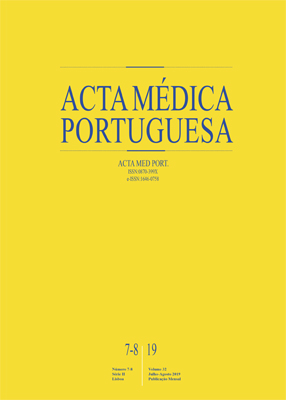Subtelomeric Rearrangements: Presentation of 21 Probands with Emphasis on Familial Cases
DOI:
https://doi.org/10.20344/amp.11466Keywords:
Intellectual Disability/genetics, Subtelomeric Rearrangements Gene Rearrangement/genetics, Telomere/geneticsAbstract
Introduction: Intellectual disability affects 2% – 3% of the general population, with a chromosomal abnormality being found in 4% – 28% of these patients and a cryptic subtelomeric abnormality in 3% – 16%. In most cases, these subtelomeric rearrangements are submicroscopic, requiring techniques other than conventional karyotype for detection. They may be de novo or inherited from an affected parent or from a healthy carrier of a balanced chromosomal abnormality. The aim of this study was to characterize patients from our medical genetics center, in whom both a deletion and duplication in subtelomeric regions were found.
Material and Methods: Clinical and cytogenetic characterization of 21 probands followed at our center, from 1998 until 2017, with subtelomeric rearrangements.
Results: There were 21 probands from 19 families presenting with intellectual disability and facial dysmorphisms. Seven had behavior changes, five had epilepsy and 14 presented with some other sign or symptom. Four had chromosomal abnormalities detected by conventional karyotype and four were diagnosed by array-comparative genomic hybridization. In four cases, parental studies were not possible. The online mendelian inheritance in man classification was provided whenever any of the phenotypes (deletion or duplication syndrome) was dominant.
Discussion: Patients and relevant family members were clinically and cytogenetically characterized. Although rare, subtelomeric changes are a substantial cause of syndromic intellectual disability with important familial repercussions. It is essential to remember that a normal array-comparative genomic hybridization result does not exclude a balanced rearrangement in the parents.
Conclusion: Parental genetic studies are essential not only for a complete characterization of the rearrangement, but also for accurate genetic counselling and screening of family members at risk for recurrence.
Downloads
Downloads
Published
How to Cite
Issue
Section
License
All the articles published in the AMP are open access and comply with the requirements of funding agencies or academic institutions. The AMP is governed by the terms of the Creative Commons ‘Attribution – Non-Commercial Use - (CC-BY-NC)’ license, regarding the use by third parties.
It is the author’s responsibility to obtain approval for the reproduction of figures, tables, etc. from other publications.
Upon acceptance of an article for publication, the authors will be asked to complete the ICMJE “Copyright Liability and Copyright Sharing Statement “(http://www.actamedicaportuguesa.com/info/AMP-NormasPublicacao.pdf) and the “Declaration of Potential Conflicts of Interest” (http:// www.icmje.org/conflicts-of-interest). An e-mail will be sent to the corresponding author to acknowledge receipt of the manuscript.
After publication, the authors are authorised to make their articles available in repositories of their institutions of origin, as long as they always mention where they were published and according to the Creative Commons license.









